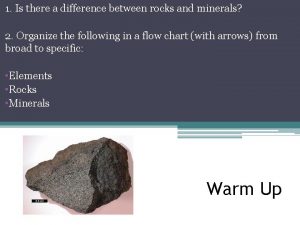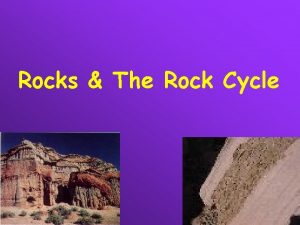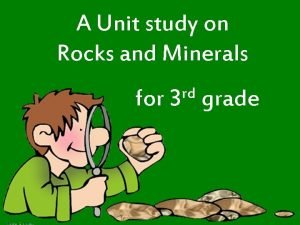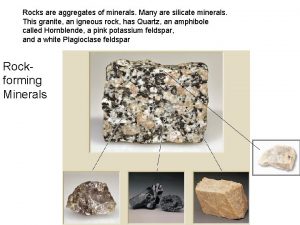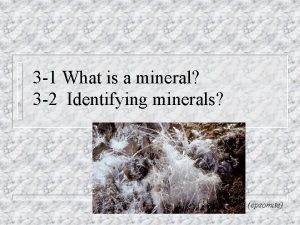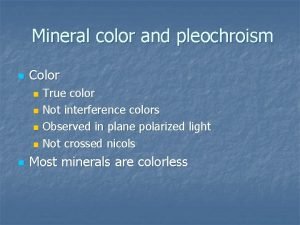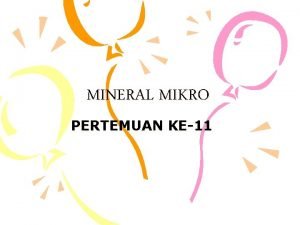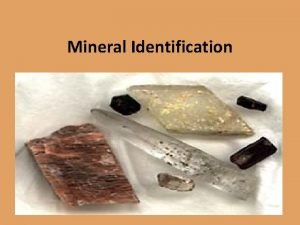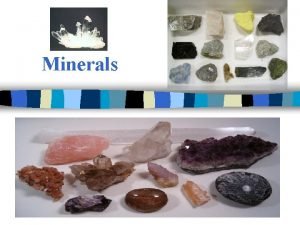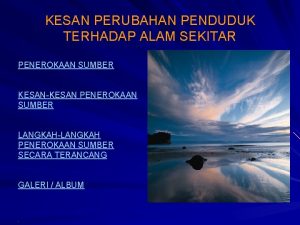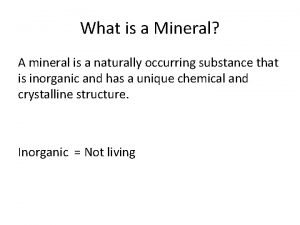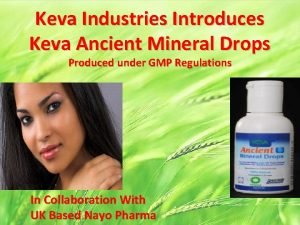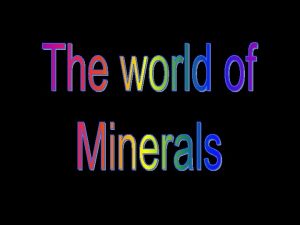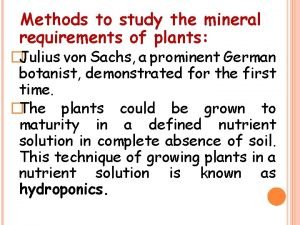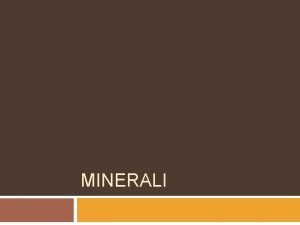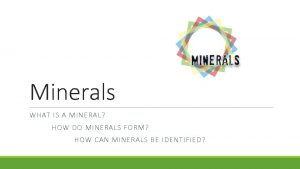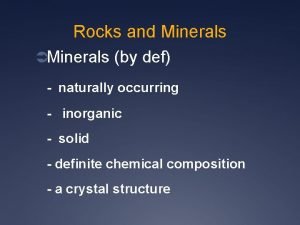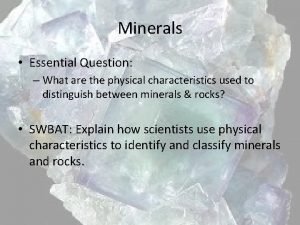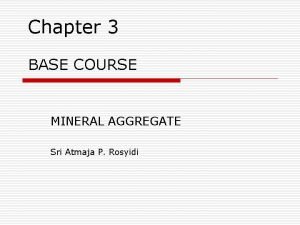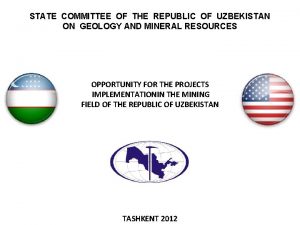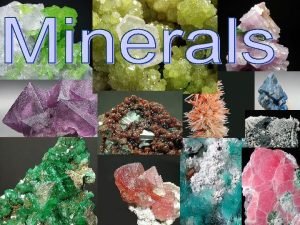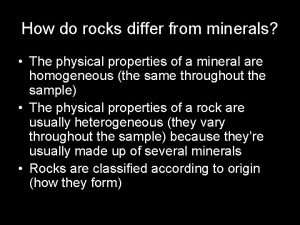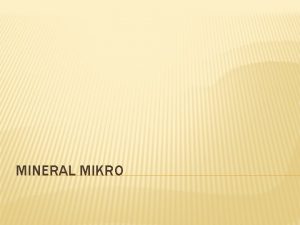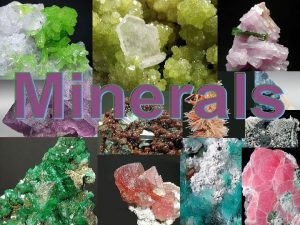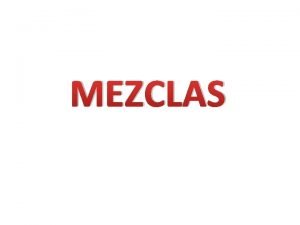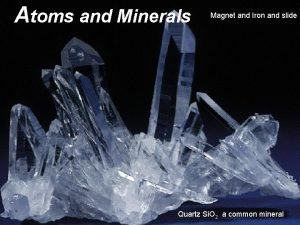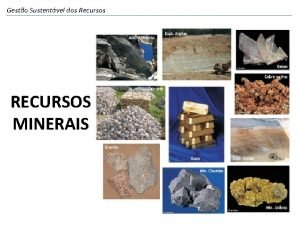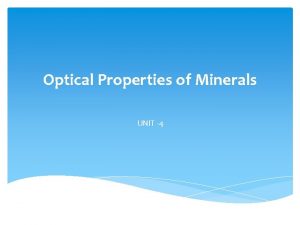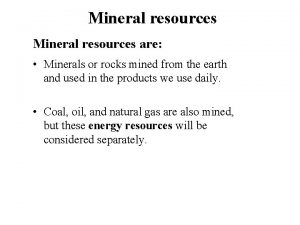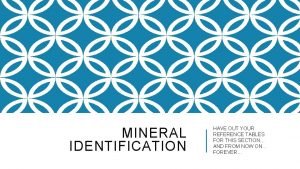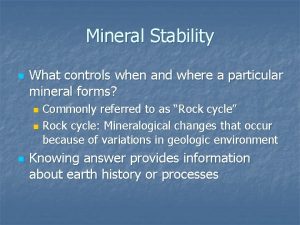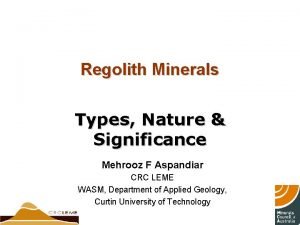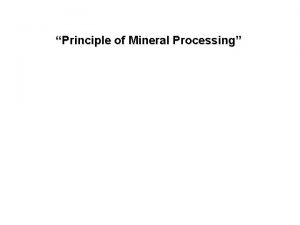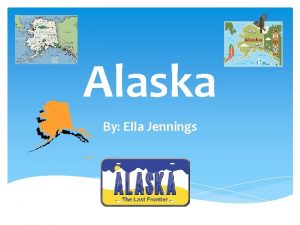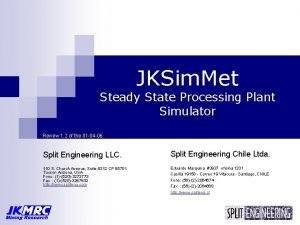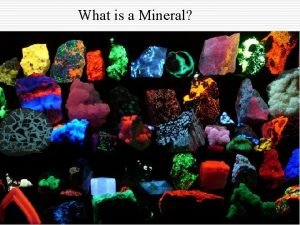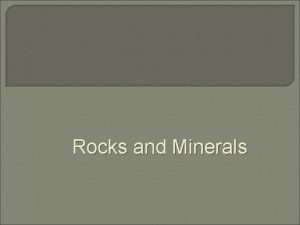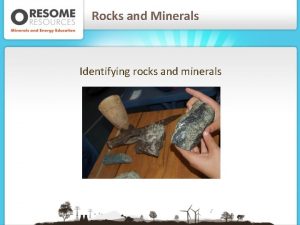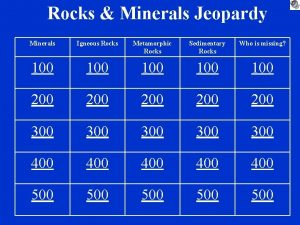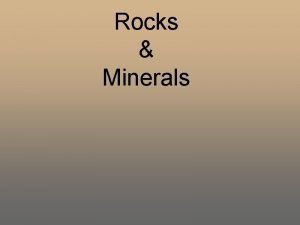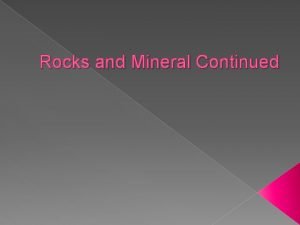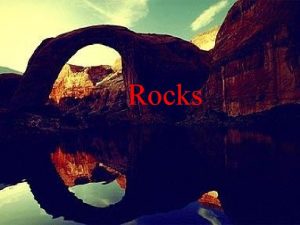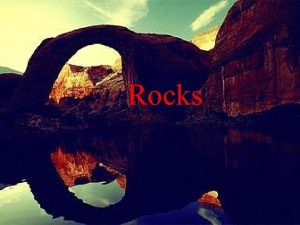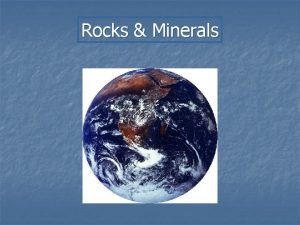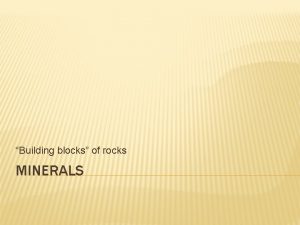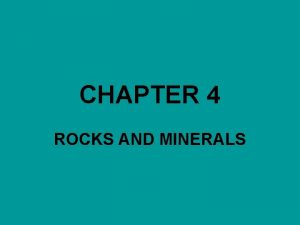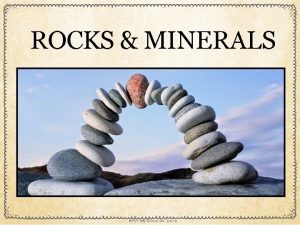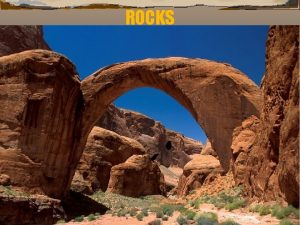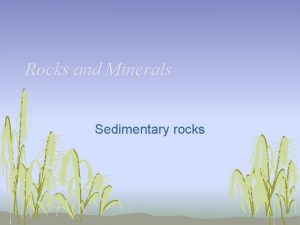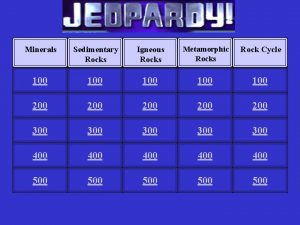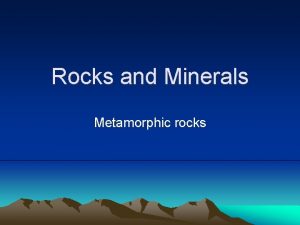Rocks Minerals Minerals What is a Mineral n






























































- Slides: 62

Rocks & Minerals

Minerals

What is a Mineral? n n n Naturally Occurring Made of Elements Solid Crystal Structure Inorganic

Naturally Occurring n Formed by natural processes not in the laboratory - Is an Ice Cube a mineral? - Is the ice on the windshield of a car a mineral?

Solid n Not gas or liquid -H 2 O as ice in a glacier is a mineral, but water is not

Definite Crystal Structure n Highly ordered atomic arrangement of atoms in regular geometric patterns Apatite Feldspar Diamond Quartz 8

Definite Chemical Formula n Minerals are expressed by a specific chemical formula -Gold (Au) -Calcite (Ca. CO 3) -Quartz (Si. O 2) -Pyrite (Fe. S 2)

Inorganic n Cannot be made from something that is or was once living.

Composition of the Earth’s Crust § Eight Elements that make up over 98% of Earth’s Crust -Oxygen (O) -Silicon (SI) -Aluminum (Al) -Iron (Fe) -Calcium (Ca) -Sodium (Na) -Potassium (K) -Magnesium (Mg)

Where Do Minerals Come From? 1) Magma 2) Evaporation

How Are Minerals Identified? n n n n Color Luster Hardness Streak Density Crystal Shape Cleavage and Fracture Special Properties

Color n Usually the first and most easily observed -Some minerals are always the same color -Some minerals can have many colors -Minerals Make up determine their color ROSE QUARTZ SMOKY QUARTZ

Luster n n General appearance of a mineral surface in reflected light. Metallic and Non Metallic Glassy-Obsidian

Hardness n n Resistance to scratching by different items; “scratchability” Determined by the crystal structure Mohs Hardness Scale >2 fingernail 3 penny ~5 Nail or Steel of a pocket knife 5. 5 Window Glass 6. 6 Steel of a file 7 quartz crystal

Mohs Mineral Hardness Scale 1) Talc Softest 2) Gypsum 1 3) Calcite 5 4) Flourite 5) Apatite 9 2 6) Feldspar 6 7) Quartz 8) Topaz 3 7 9) Corundum 10) Diamond 10 Hardest 4 8

Streak n n n The color of a finely powdered mineral Helps identify minerals true color Determined by rubbing the mineral on a piece of unglazed porcelain (streak plate)

Density n n n The amount of matter in a given space (Mass/Volume) Very helpful when identifying two minerals that look alike A mineral’s density is determined by the atoms which make up the mineral

Crystal Shape n Minerals have a characteristic crystal shape resulting from the atomic packing of the atoms when the mineral is forming

Cleavage and Fracture n n Cleavage is the tendency of a mineral to split or crack along parallel or flat planes Fracture occurs when a mineral breaks at random lines instead of at consistent cleavage planes. BIOTITE 1 Direction of Cleavage QUARTZ No Cleavage Obsidian Conchoidal Fracture

Reaction to acid n The carbonite minerals with dilute hydrocloric acid by fizzing

Magnetism n n n Use a magnet; see if the mineral moves toward the magnet Magnetism occurs when there is an imbalance in the structural arrangement of the iron ions Example Magnetite

Special Properties n n n Magnetism (Magnetite) Glowing under ultraviolet light (Fluorite) Salty taste (Halite) Smell (Sulfur) Magnetite Reaction to HCl (Calcite)

Economic Importance of Minerals n Minerals are in many things we see and use everyday such as; bricks, glass, cement, plaster, iron, gold

Every American Requires 40, 000 Pounds of New Minerals per Year n at this level of consumption the average newborn infant will need a lifetime supply of: -795 lbs of lead (car batteries, electric components) -757 lbs of zinc (to make brass, rubber, paints) -1500 lbs of copper (electrical motors, wirings -3593 lbs aluminum (soda cans, aircraft) -32, 700 lbs of iron (kitchen utensils, automobiles, buildings) -28, 213 lbs of salt (cooking, detergents) -1, 238, 101 lbs of stone, sand, gravel, cement (roads, homes, etc. )

Rocks

Rocks § Made of two or more different minerals that have been: n cemented together n squeezed and heated together n melted and cooled together.

Types of Rocks n n n Igneous Sedimentary Metamorphic

What Rocks Mean Sedimentary Rocks n Record of the earth's ancient surface environments and of life. n Record of crustal movement. Igneous Rocks n Indicate crustal movement n Unusual heat in the crust or mantle. Metamorphic Rocks n Indicate crustal movement n Indicate uplift and erosion n Indicate (mountain-building) events

What Rocks Tell Us Rock Type Igneous Sedimentary How Classified Composition Texture Chemical Composition Grain Size Composition Metamorphic Mineral Makeup What it Tells Us Tectonic Setting Cooling History Surface Environment Energy of Environment Original Rock Type Temperature, Pressure

Distribution of Rocks in the U. S.



The Rock Cycle is a group of changes, this change does not necessarily have to be a chemical change. Igneous rock can change into sedimentary rock or into metamorphic rock. Sedimentary rock can change into metamorphic rock or into igneous rock. Metamorphic rock can change into igneous or sedimentary rock. Almost all of rock today that we have on earth is made up of all the same stuff as the rocks that dinosaurs and other ancient life forms walked, crawled, or swam over While the stuff that rocks are made of has stayed the same, the rocks themselves, have not Over time rocks are recycled into other rocks Moving tectonic plates are responsible for destroying and forming many types of rocks

Rock divisions occur in three major families based on how they formed: igneous, sedimentary, and metamorphic. Each group contains a collection of rock types that differ from each other on the basis of the size, shape, and arrangement of mineral grains. Just remember 3 types of rocks=3 divisions. (igneous, sedimentary, and metamorphic)

When classifying a rock sample geologists observe the rock’s color and texture and determine its mineral composition. Texture: the size, shape, and pattern of the rock’s grain. Color: the apparent color of the rock, on the inside and the outside. Mineral composition: The minerals that make up the different parts of a rock.

Igneous Rocks n Most igneous rocks are produced deep underground by the cooling and hardening of magma

Igneous Rocks n These are rocks formed by the cooling of molten rock (magma. ) Magma cools and solidifies forming igneous rocks volcano magma

Classification of Igneous Rocks n n Composition-refers to the minerals that make up the rock Texture-shape, size, arrangement and distribution of minerals that make up the rock

Composition n Extrusive- Formed from lava; volcanic Outside Obsidian n Pumice Intrusive- Formed deep within the earth. Inside Granite

Textures n Glassy Obsidian n Fine-grained Basalt n Coarse-grained Granite

Classification of Sedimentary Rocks n n n Detrital Rocks- Made of the fragments of previously existing rocks Organic Rocks- Come from organisms Chemical Rocks- Formed by inorganic processes such as evaporation

Sedimentary Rocks n Getting older Sedimentary Rocks are rocks formed when particles of sediment build up and are “cemented together” by the effect of pressure and minerals. Fragments washed to the sea Rocks are broken up by the action of weather sea Sedimentary rocks

Clastics Rocks n Conglomerate n Sandstone n Mudstone

Organic Rocks n Limestone Coquina Fossiliferous Limestone

Chemical Rocks n Limestone

Sedimentary rocks form from particles deposited by water and wind If you have ever walked along a beach (which I am sure you have) you may have noticed tiny sand grains, mud, and pebbles. These are some sediments that eventually form into sedimentary rocks Sedimentary Rocks can form in 4 ways by: Erosion Deposition Compaction Cementation

Lithification n n The process by which sediment becomes sedimentary rock 1 st step : erosion 2 nd step : deposition 3 rd step : compaction 4 th step : cementation

Sedimentary Rocks : Erosion Destructive forces are constantly breaking up and wearing away all the rocks on Earth’s surface The forces include heat and cold, rain, waves, and grinding ice Erosion occurs when running water or wind loosens and carry away the fragments of rock.

Sedimentary Rocks: Deposition Eventually, the moving water or wind slows and deposits the sediment. If water is carrying the sediment, rock fragments and other materials sink to the bottom of a lake or ocean. Deposition is the process by which sediment settles out of the water or wind carrying it. After sediment has been deposited, the processes of compaction and cementation change the sediment into sedimentary rock. In addition to particles of rock, sediment may include shells, bones, leaves, stems, and other remains of living things. Over time, any remains of living things in the sediment may slowly harden and change into fossils trapped in the rock.

Sedimentary Rocks: Compaction At first the sediments fit together loosely. But gradually, over millions of years, thick layers of sediment build up. These layers are heavy and press down on the layers beneath them. Then compaction occurs. Compaction is the process that presses sediments together. Year after year more sediment falls on top, creating new layers. The weight of the layers further compacts the sediments, squeezing them tightly together. The layers often remain visible in the sedimentary rock.

Sedimentary Rocks: Cementation While compaction is taking place, the minerals in the rock slowly dissolve in the water. The dissolved minerals seep into the spaces between particles of sediment. Cementation is the process in which dissolved minerals crystallize and glue particles of sediment together. It often takes millions of years for compaction and cementation to transform loose sediments into solid sedimentary rock.

Sedimentary Transformations Point A: water or wind deposits sediments Point B: The heavy sediments press down on the layers beneath Point C: Dissolved minerals flow between the particles and cement them together

Types of Sedimentary Rocks Sandstone Limestone Gypsum Conglomerate Shale

Metamorphic Rocks n n Foliated- Parallel alignment of flattened mineral grains and pebbles Unfoliated-Rocks that are not banded and do not break into layers

Metamorphic Rocks n n Metamorphic rocks are formed by the effect of heat and pressure on existing rocks. This can greatly affect the hardness, texture or layer patterns of the rocks. Pressure from surface rocks metamorphic rock Magma heat forming here

Foliated Gneisse

Unfoliated Marble

Igneous Rocks n Most igneous rocks are produced deep underground by the cooling and hardening of magma

Sedimentary Rocks n Formed from the breaking apart of other rocks (igneous, metamorphic, or sedimentary rocks) that have cemented, compacted together. Types of Sedimentary Rocks Detrital – always has a granular texture Chemical- come out of solution or are left behind by evaporation Organic- made of the remains of once living organisms

Fact about the Mississippi River Did You Know? n n The Mississippi River carries an average of 436, 000 tons of sediment each day It moves an average of 159, 000 tons of sediment a year

Metamorphic Rocks n Rocks that have changed because of changes in temperature and pressure. Metamorphic rocks can form from igneous, sedimentary or other metamorphic rocks. Classifying Metamorphic Rocks • Foliated- (banded or layering) EX: slate and gneiss • Nonfoliated- minerals grow and rearrange but not in layers Ex: marble

The Rock Cycle n The diagram of the rock cycle shows how the earth's rocks are changed again and again
 Igneous rocks metamorphic rocks and sedimentary rocks
Igneous rocks metamorphic rocks and sedimentary rocks Rock cycle
Rock cycle Poem about minerals and rocks 3 stanza
Poem about minerals and rocks 3 stanza Why is bowen's reaction series important
Why is bowen's reaction series important Difference between rocks and stones
Difference between rocks and stones Rock vs mineral
Rock vs mineral Difference between minerals and rocks
Difference between minerals and rocks Rock type
Rock type Rocks are aggregates of minerals
Rocks are aggregates of minerals Concept map types of rocks
Concept map types of rocks Rocks and minerals song
Rocks and minerals song Volcanic rocks and plutonic rocks
Volcanic rocks and plutonic rocks How is intrusive igneous rock formed
How is intrusive igneous rock formed Types of mineral luster
Types of mineral luster It is the true color of mineral
It is the true color of mineral Kegunaan tanih
Kegunaan tanih Balarila halimbawa
Balarila halimbawa Mineral mikro
Mineral mikro Mineral springs middle
Mineral springs middle Directions of cleavage
Directions of cleavage Mineral
Mineral Kesan penerokaan arang batu
Kesan penerokaan arang batu Pengaruh pengolahan terhadap mineral
Pengaruh pengolahan terhadap mineral Mineral oil hlb
Mineral oil hlb What type of mineral
What type of mineral Casparian strip function in plants
Casparian strip function in plants Keva mineral drops demo
Keva mineral drops demo Mineral acid examples
Mineral acid examples Polyetheretherketone mineral filled film
Polyetheretherketone mineral filled film Knowledge based system definition
Knowledge based system definition Reino mineral espiritismo
Reino mineral espiritismo Words like shiny, glassy, waxy or dull describe a mineral's
Words like shiny, glassy, waxy or dull describe a mineral's Precipitation of proteins by strong mineral acids
Precipitation of proteins by strong mineral acids Classification of emulsifying agents ppt
Classification of emulsifying agents ppt Mineral nutrition in plants ppt
Mineral nutrition in plants ppt Mineral streak
Mineral streak Mohsova trdotna lestvica
Mohsova trdotna lestvica Mineral fertilizer
Mineral fertilizer Nature recycling system
Nature recycling system Mineral are
Mineral are Naturally occurring mineral
Naturally occurring mineral Mineral streak
Mineral streak Mineral aggregate definition
Mineral aggregate definition Uzbekistan mineral resources
Uzbekistan mineral resources Calcite vs gypsum
Calcite vs gypsum Sifat-sifat bahan serat alam mineral
Sifat-sifat bahan serat alam mineral Rock vs mineral
Rock vs mineral Mineral mikro
Mineral mikro Na mineral
Na mineral Destilacion fraccionada
Destilacion fraccionada Minerals non examples
Minerals non examples Recursos minerais portugal
Recursos minerais portugal Giz
Giz Basal section mineral
Basal section mineral Is quartza mineral
Is quartza mineral Mineral reference table
Mineral reference table Mineral stability
Mineral stability Mineral council australia
Mineral council australia Principles of mineral processing
Principles of mineral processing Alska state bird
Alska state bird Steady state windows 10
Steady state windows 10 Strip mining vs open pit mining
Strip mining vs open pit mining Luster mineral
Luster mineral




